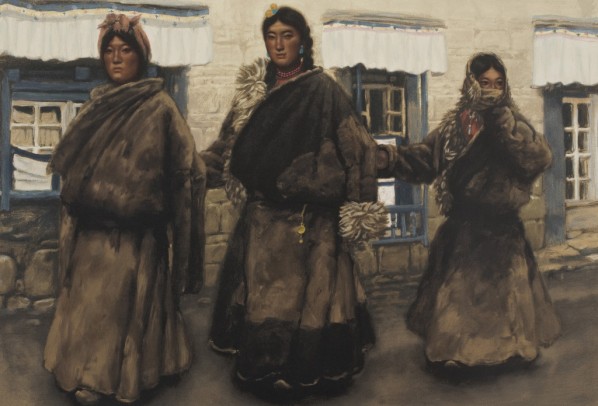
Chen Danqing-Mothers and Children, Series of Tibet, 1982; oil on canvas
by Pan Gaojie
Some time ago, I saw Chen Danqing's exhibition –the print art entitled "Tibetan Group Picture". The print "Tibetan Group Picture" is not Chen Danqing's authentic work and it is made by a teacher from the print studio of the Tianjin Academy of Fine Arts in accordance with the old series.
Back to the historical background of this group of paintings, the "Tibetan Group Picture" caused an uproar in the art world in 1980, critics believed that it stepped over the trend "scar art" and switched to focus on a kind of simple and unadorned localism , then came the "local realistic painting" wave which refreshed people at that time.
In 1980, Chen Danqing mentioned in his "seven of my paintings" that "art made a big circle, the original can go to paint what my eyes see' ", it is conceivable that in the early eighties that this kind of revolutionary trend would cause a stir in art circles. A long time before that, painting was presented in the attitude of "helping enlightenment, helping ethics" in various periods in China. And in the seventies and eighties, the mission of painting was to serve politics and the revolution, to some extent then prevalent "scar art" was also the continuation of side-effects of political movements, but the political extension made people nervous in a state of tension for a long period , people would inevitably be tired of thinking and reveal disgust, whereas the emergence of the "Tibetan group picture" happens to fulfill the dual needs of people's longing for new vision and new spirit.

Pilgrimage

Go to Town I

Go to Town II
When Chen Danqing's "Tibetan Group Picture" received success, a constant stream of artists entered the Tibetan area for life drawing which still continues today. It is understandable that the city's modern industrial civilization is tiresome, artists hope to recombine their visual structure to provoke a different kind of inspiration in Tibet's original ecological environment and different customs. But compared to Yunnan, Guizhou which also has an original ecology, the inspiration is particularly popular in Tibet. So, this phenomenon will be referred to as a follower strategy, Chen Danqing's "Tibetan group painting" is a successful precedent that attracts groups of artists or "fans" throwing themselves into the "Tibetan theme". Tibetan group pictures renouncing the world due to historical circumstances reflect its meaning and value, but can the following "Tibetan theme" painting demonstrate their worth? Most artists would not think about this problem, just as Chen Danqing said - I only pay attention to form. "But if it is an art form, it has always been 'a significant' form, 'naturalistic' form that is relevant to the era focusing on psychology and 'collective unconsciousness' and returning to the basics, otherwise, why did the" Tibetan group picture "and" father " that came out at the same time while separated by thousands of miles in the north and south ? " Gao Minglu said it did..

Chen Danqing-Sheepherder, Series of Tibet

Kamba Men

Wind-swept Pastures

Whistling Wasteland
So, by following the trend of the "Tibetan theme" is there a manifestation that artists intend to pursue formal beauty? Tibetan costume and plateau ecological environment can be shown as more complicated and varied lines, colors, levels than normal subjects. The "Tibetan theme" is easy to show, but the abuse of it, blindly following the trend and the deliberate arrangement, is dropping into the "theme model" just as Gao Minglu cited in the "The genre of oil painting's development in recent years"—like pastoral and grassland, farmers and cattle, mother and child (feeding) and other examples, they have become a "quasi-interest in life" and "Pan natural" program.
In the foreword,Chen Danqing gave a higher rating to these sets of prints. The drafts, the "remaining dream traces", incidental or consequential, created a group of works engraved by history which became part of the evidence of China's modern art history. An era long gone, it is pleasing that we can feel the remnants of breath then from this evidence.
Throughout each historical period, there will always be a sensitive outstanding person who is at the forefront of the trend, followers as a foil of doozer is also understandable, but being buried in the era of the torrent. All that is real is rational and all that is rational is real, it's better to wait and see.
About the author
Pan Gaojie
Born in Guangxi Province,China in 1990
Grown in Guangdong Province since 1995
Currently studying in Beijing
Education
2009—— ,Study in Art History Department of Humanities Institute,Central Academy of Fine Arts, Beijing.
Constellation
Sagittarius
E-mail: pgj1211@gmail.com
Blog: http://blog.163.com/pgj1211@yeah/
Weibo: http://weibo.com/pantea
The views expressed in this column are the author’s own and do not represent those of CAFA ART INFO.




























